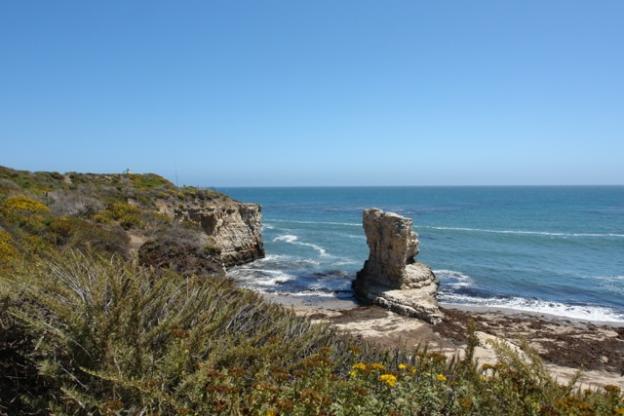Exploring Younger Lagoon, one of the star wetlands of the Central Coast and part of the UC Natural Reserve System.
Story and photos by Diane Terry
July 8, 2014—Living amongst the hustle and bustle of the beach crowds, we Central Coast dwellers get a special feeling when we stumble upon a seemingly untouched stretch of sand. Finding such a “secret” spot feels less like a trip to the beach than a serendipitous opportunity to observe a unique ecosystem, with the marine critters carrying on without human disruption. These spots are few and far between, and are most likely not as undisturbed as you’d like to believe. However, some pieces of our coast have been closed off completely, lending us the opportunity to learn more about our natural coastal ecosystems.
As part of the University of California’s Natural Reserve System, Younger Lagoon is a unique local treasure that hosts both resident and migratory species. Only a handful of relatively undisturbed wetlands exist on the Central Coast, and Younger Lagoon is one of them.
The reserve contains multiple habitats, including salt and freshwater marsh, coastal strand, steep bluffs, pocket beach, grassland, backdune pickleweed flat and dense willow thickets. Located just north of the Monterey Bay, the reserve nests between the ocean and Highway 1 north of Natural Bridges State Beach and south of Wilder Creek (part of Wilder Ranch State Park). This 72-acre plot was gifted to the university by the Younger family in 1973, and is generally closed off to the public to serve as a research opportunity for students and scientists alike.
By sharing research obtained from Younger Lagoon across multiple databases, scientists can develop a deeper understanding of similar ecosystems. This is especially helpful for public beaches — such as Natural Bridges and parts of Wilder Ranch — since human disruption interferes with research. Although Younger Lagoon is not open to recreational use, on certain Thursdays and Sundays this summer the gates open up for public tours led by Seymour Center docents. Ready for a little adventure within city limits, I signed my roommate and myself up for a tour a couple of weeks ago.
North Coast Geography Lesson
At the Seymour Center, we meet the folks who will be our fellow adventurers for the next 90 minutes and head over to the locked gate to the lagoon. We were warned to bring layers, and as I shiver and zip up my jacket, I’m glad I heeded the warning. Our guide for the day, Paul Van Loan, jokes that he’s never seen the wind die down over here.
We congregate at a sheltered overlook near the entrance and start the tour with a lesson in the reserve’s geography. This spot is one of the best on the coast to see the marine terraces that have formed over hundreds of thousands of years. Two natural occurrences shape this natural feature: the tectonic lifting caused by activity along the San Andreas fault, forming the terraces; and glacial processes that change the sea level, thus eroding the steps. Van Loan adds with a chuckle that gophers have also aided in the erosion process over the years.
Like a natural staircase to the mountains, the terraces and the slopes in between illustrate these processes all along the North Coast. The terrace closest to the ocean—where we currently sit—doesn't have a slope like the rest. Instead it has a steep bluff. In due time, however, with help from glacial processes and gophers, this will eventually form a slope like the rest.
Read more about marine terraces in this article by Mobile Ranger's Julia Gaudinsky.
Van Loan brings us back to the present to talk about what’s going on right in front of us. Tall, metal rods stick out of a murky body of light brown water: Younger Lagoon itself. Since this lagoon is brackish (containing both fresh and saltwater), these rods serve the purpose of recording the levels of salinity within the lagoon. This giant puddle isn't touching the ocean, though, so I find myself wondering, how does it contain saltwater? Turns out that even though the lagoon is separated from the ocean by a berm (a raised barrier of sand), the waves tend to crash over the berm and pour into the lagoon during rough storms, usually during the winter. The freshwater in the lagoon is constantly replenished by overland runoff and precipitation.
Native Plant Wonderland
As we enter the trailhead, I am immediately engulfed in the incredible smells of the surrounding plants. We are told that this whole area has been, and continues to be, a battle against invasive species, and a lot of work has gone into replanting native species. I appreciate the hard work, not only because it’s an important environmental achievement, but because it simply smells wonderful. I wish I could communicate smells through computer screens, but you’ll just have to experience this for yourself.
As we pass through a grove of sage, yellow lupine, poison oak, an array of tall grasses and one interesting pile of bobcat scat, we find ourselves at the perfect vantage point overlooking the water. We focus on one rock structure in particular, one that juts out into the sky and stands on its own. Apparently, this rock stack used to be a long arc structure with multiple "windows" within it. All it took was one stormy night in 1992 to drag most of it into the sea, leaving one stack behind. After learning about the slow and tedious process of erosion that had created the landscape behind us, I’m dumbfounded by the story behind this rock formation. I’m still pondering the strangeness of this when all of a sudden, we are trekking down the slope to the berm.
Once we carefully side-step the yellow sand verbena scattered along the sand, we make it to the berm and get a closer look at the seabird life buzzing around us. Gulls stand up, wary of our appearance on the scene, while sandpipers dodge the incoming waves. We make our way to a small triangle-shaped cave embedded within the mudstone cliff to the right of the lagoon, more evidence of slow erosion. We don’t stay long, however, as the rising tide threatens to soak our feet.
Back at the lagoon, we take a closer look at the murky water, spying a few small tidewater goby fish, which love the low oxygen and high salinity levels of the lagoon. We also investigate a couple of mysterious rocks that have perfect holes seemingly drilled into them, something I’ve noticed before along the coast but never bothered to question. According to Van Loan, these holes are caused by mussels, not drills, which slowly dig their feet into the rock, latching themselves in. Leaving everything as is, we replace the rock and trek back up the slope, locking the gate behind us.
As the tour draws to a close, I feel a sense of leaving a different world. There's something exciting about getting a sneak peak into an area that's usually closed off to public, especially when that area is deemed to be such a thriving and unique ecosystem that it was included in the reserve system. Also, being a student, I can always appreciate the opportunity to learn in a setting where it doesn't feel like learning — you know, when you soak up all that information without having to think about it. We never stop learning, as the saying goes, and this opportunity to see Younger Lagoon is a rewarding and unique adventure for anyone who signs up.
We say goodbye to our adventure pals, but it’s a see-you-later, not a goodbye, to the Seymour Center. I've got my eye on that Marine Mammal Research Tour next.
Younger Lagoon Reserve Tours happen on certain Sundays and Thursdays throughout the summer. Tours are limited to groups of 12. Free with admission (which is free for Seymour Center Members and UCSC undergrads). The next tour is Sunday, July 13th, at 2pm. For more info or to RSVP, call 831.459.3800.
Category:

























